Economics Assignment: Analysis of the Cheese Industry in Australia
VerifiedAdded on 2022/11/16
|6
|834
|404
Report
AI Summary
This economics assignment analyzes the Australian cheese industry, focusing on the patterns of demand and supply within the context of Bega Cheese Limited and its competitors, including Fonterra and Lion. The report examines the increasing demand for cheese, influenced by factors such as population growth and the closure of dairy cooperatives, while the supply is affected by droughts and other issues. It identifies the current market structure as monopolistic competition and discusses barriers to entry. The analysis includes the impact of demand and supply shifts, the price elasticity of demand among different cheese brands, and the effects of substitute and complementary goods. The assignment incorporates relevant economic concepts and provides a comprehensive understanding of the cheese market dynamics.
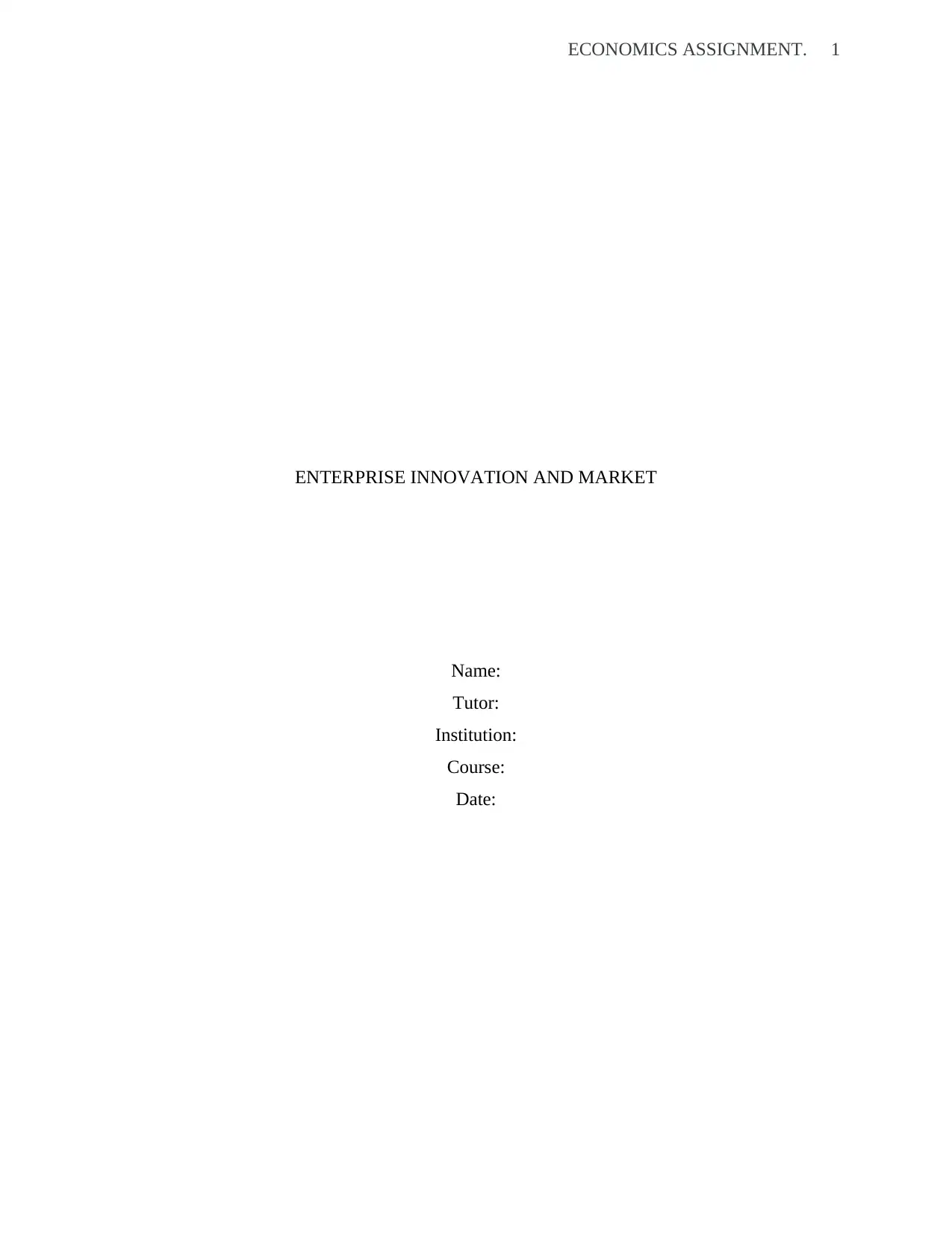
ECONOMICS ASSIGNMENT. 1
ENTERPRISE INNOVATION AND MARKET
Name:
Tutor:
Institution:
Course:
Date:
ENTERPRISE INNOVATION AND MARKET
Name:
Tutor:
Institution:
Course:
Date:
Paraphrase This Document
Need a fresh take? Get an instant paraphrase of this document with our AI Paraphraser
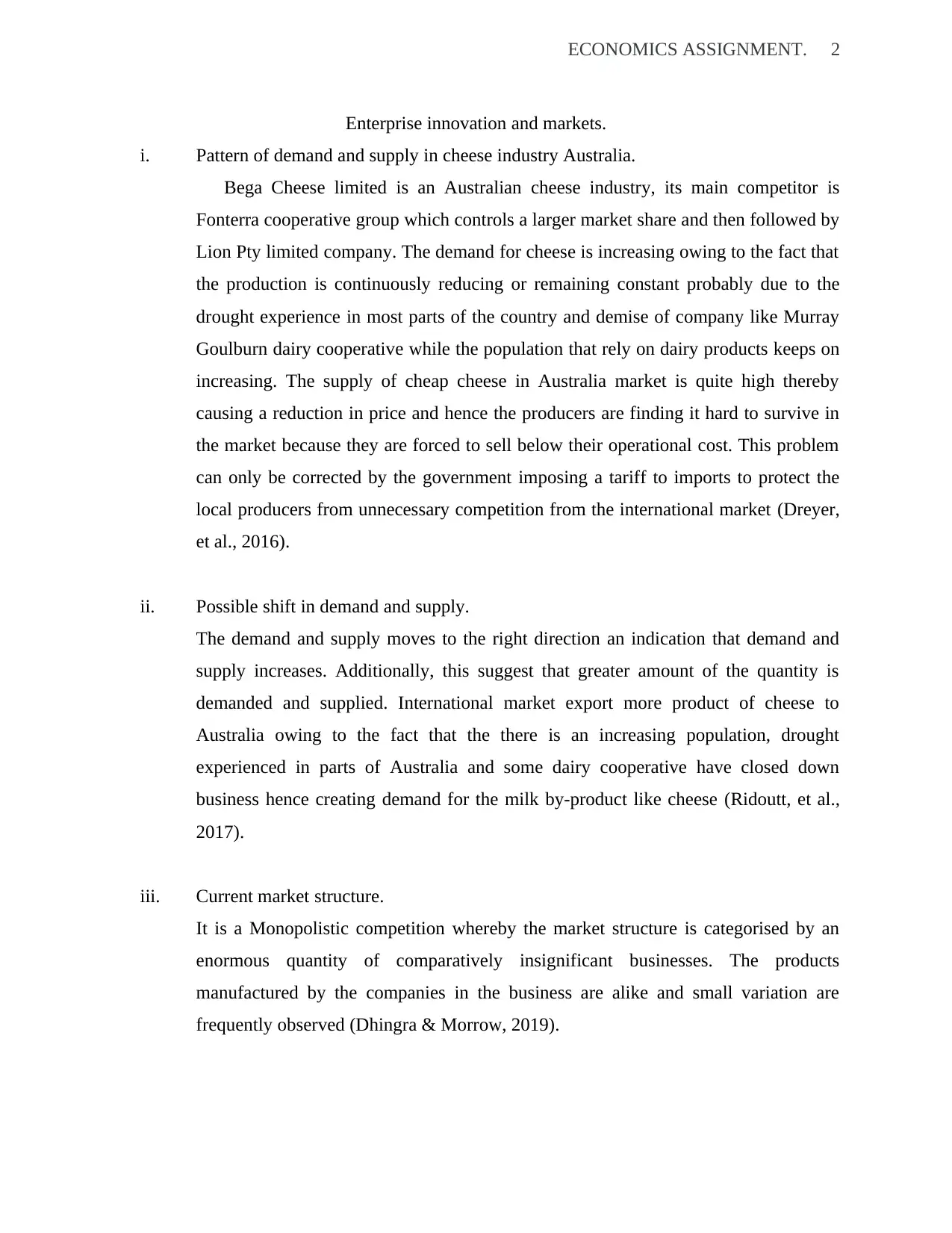
ECONOMICS ASSIGNMENT. 2
Enterprise innovation and markets.
i. Pattern of demand and supply in cheese industry Australia.
Bega Cheese limited is an Australian cheese industry, its main competitor is
Fonterra cooperative group which controls a larger market share and then followed by
Lion Pty limited company. The demand for cheese is increasing owing to the fact that
the production is continuously reducing or remaining constant probably due to the
drought experience in most parts of the country and demise of company like Murray
Goulburn dairy cooperative while the population that rely on dairy products keeps on
increasing. The supply of cheap cheese in Australia market is quite high thereby
causing a reduction in price and hence the producers are finding it hard to survive in
the market because they are forced to sell below their operational cost. This problem
can only be corrected by the government imposing a tariff to imports to protect the
local producers from unnecessary competition from the international market (Dreyer,
et al., 2016).
ii. Possible shift in demand and supply.
The demand and supply moves to the right direction an indication that demand and
supply increases. Additionally, this suggest that greater amount of the quantity is
demanded and supplied. International market export more product of cheese to
Australia owing to the fact that the there is an increasing population, drought
experienced in parts of Australia and some dairy cooperative have closed down
business hence creating demand for the milk by-product like cheese (Ridoutt, et al.,
2017).
iii. Current market structure.
It is a Monopolistic competition whereby the market structure is categorised by an
enormous quantity of comparatively insignificant businesses. The products
manufactured by the companies in the business are alike and small variation are
frequently observed (Dhingra & Morrow, 2019).
Enterprise innovation and markets.
i. Pattern of demand and supply in cheese industry Australia.
Bega Cheese limited is an Australian cheese industry, its main competitor is
Fonterra cooperative group which controls a larger market share and then followed by
Lion Pty limited company. The demand for cheese is increasing owing to the fact that
the production is continuously reducing or remaining constant probably due to the
drought experience in most parts of the country and demise of company like Murray
Goulburn dairy cooperative while the population that rely on dairy products keeps on
increasing. The supply of cheap cheese in Australia market is quite high thereby
causing a reduction in price and hence the producers are finding it hard to survive in
the market because they are forced to sell below their operational cost. This problem
can only be corrected by the government imposing a tariff to imports to protect the
local producers from unnecessary competition from the international market (Dreyer,
et al., 2016).
ii. Possible shift in demand and supply.
The demand and supply moves to the right direction an indication that demand and
supply increases. Additionally, this suggest that greater amount of the quantity is
demanded and supplied. International market export more product of cheese to
Australia owing to the fact that the there is an increasing population, drought
experienced in parts of Australia and some dairy cooperative have closed down
business hence creating demand for the milk by-product like cheese (Ridoutt, et al.,
2017).
iii. Current market structure.
It is a Monopolistic competition whereby the market structure is categorised by an
enormous quantity of comparatively insignificant businesses. The products
manufactured by the companies in the business are alike and small variation are
frequently observed (Dhingra & Morrow, 2019).
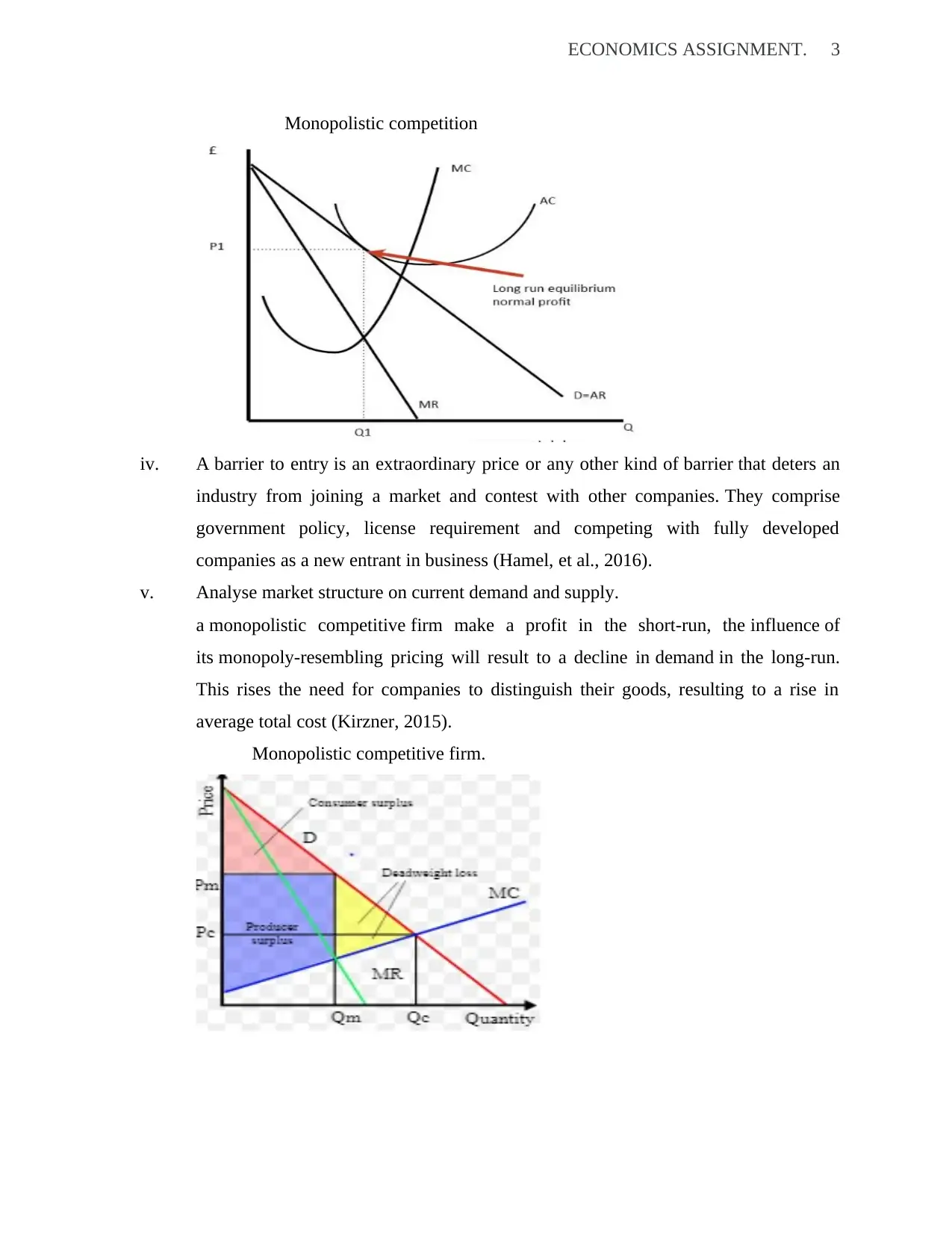
ECONOMICS ASSIGNMENT. 3
Monopolistic competition
iv. A barrier to entry is an extraordinary price or any other kind of barrier that deters an
industry from joining a market and contest with other companies. They comprise
government policy, license requirement and competing with fully developed
companies as a new entrant in business (Hamel, et al., 2016).
v. Analyse market structure on current demand and supply.
a monopolistic competitive firm make a profit in the short-run, the influence of
its monopoly-resembling pricing will result to a decline in demand in the long-run.
This rises the need for companies to distinguish their goods, resulting to a rise in
average total cost (Kirzner, 2015).
Monopolistic competitive firm.
Monopolistic competition
iv. A barrier to entry is an extraordinary price or any other kind of barrier that deters an
industry from joining a market and contest with other companies. They comprise
government policy, license requirement and competing with fully developed
companies as a new entrant in business (Hamel, et al., 2016).
v. Analyse market structure on current demand and supply.
a monopolistic competitive firm make a profit in the short-run, the influence of
its monopoly-resembling pricing will result to a decline in demand in the long-run.
This rises the need for companies to distinguish their goods, resulting to a rise in
average total cost (Kirzner, 2015).
Monopolistic competitive firm.
⊘ This is a preview!⊘
Do you want full access?
Subscribe today to unlock all pages.

Trusted by 1+ million students worldwide
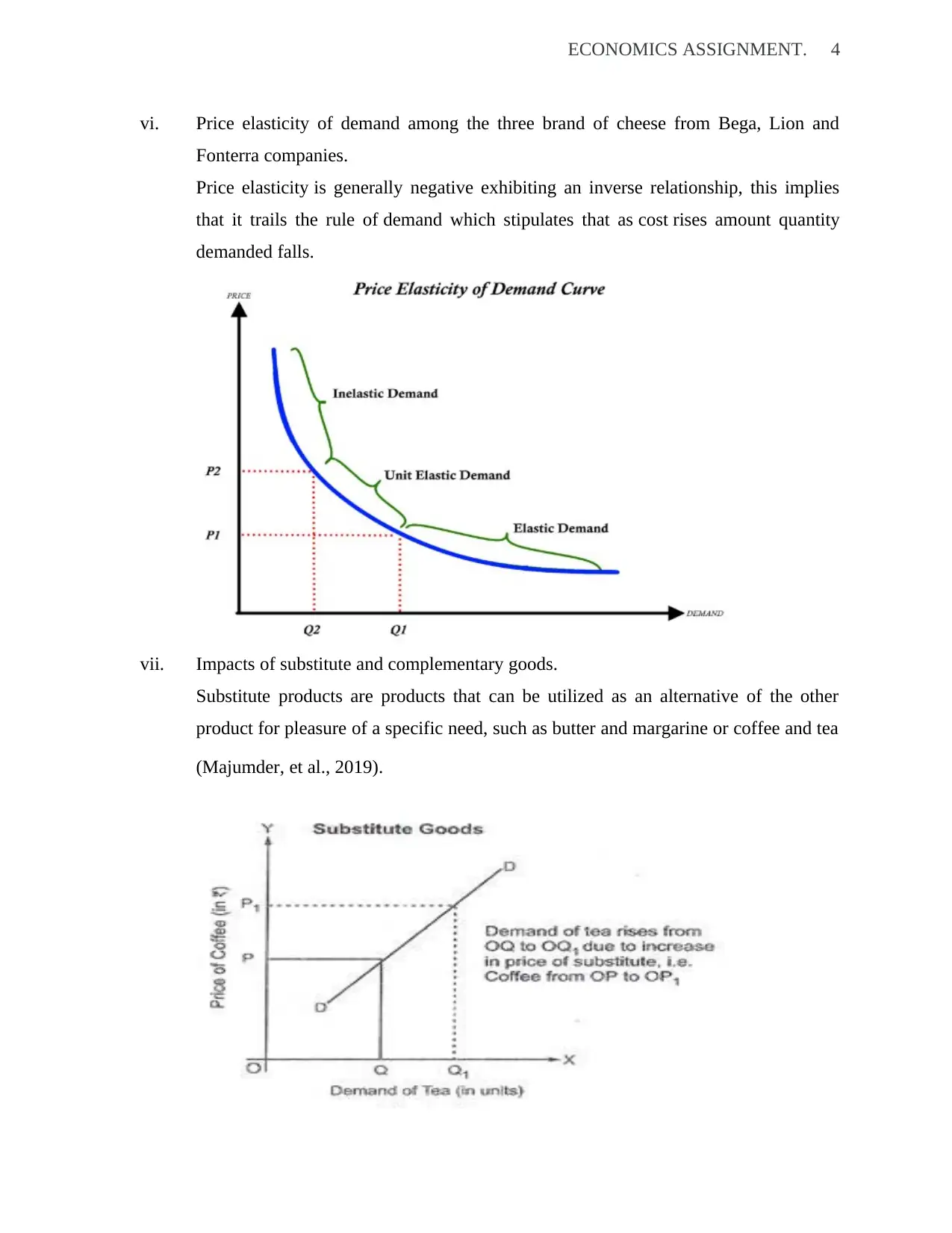
ECONOMICS ASSIGNMENT. 4
vi. Price elasticity of demand among the three brand of cheese from Bega, Lion and
Fonterra companies.
Price elasticity is generally negative exhibiting an inverse relationship, this implies
that it trails the rule of demand which stipulates that as cost rises amount quantity
demanded falls.
vii. Impacts of substitute and complementary goods.
Substitute products are products that can be utilized as an alternative of the other
product for pleasure of a specific need, such as butter and margarine or coffee and tea
(Majumder, et al., 2019).
vi. Price elasticity of demand among the three brand of cheese from Bega, Lion and
Fonterra companies.
Price elasticity is generally negative exhibiting an inverse relationship, this implies
that it trails the rule of demand which stipulates that as cost rises amount quantity
demanded falls.
vii. Impacts of substitute and complementary goods.
Substitute products are products that can be utilized as an alternative of the other
product for pleasure of a specific need, such as butter and margarine or coffee and tea
(Majumder, et al., 2019).
Paraphrase This Document
Need a fresh take? Get an instant paraphrase of this document with our AI Paraphraser
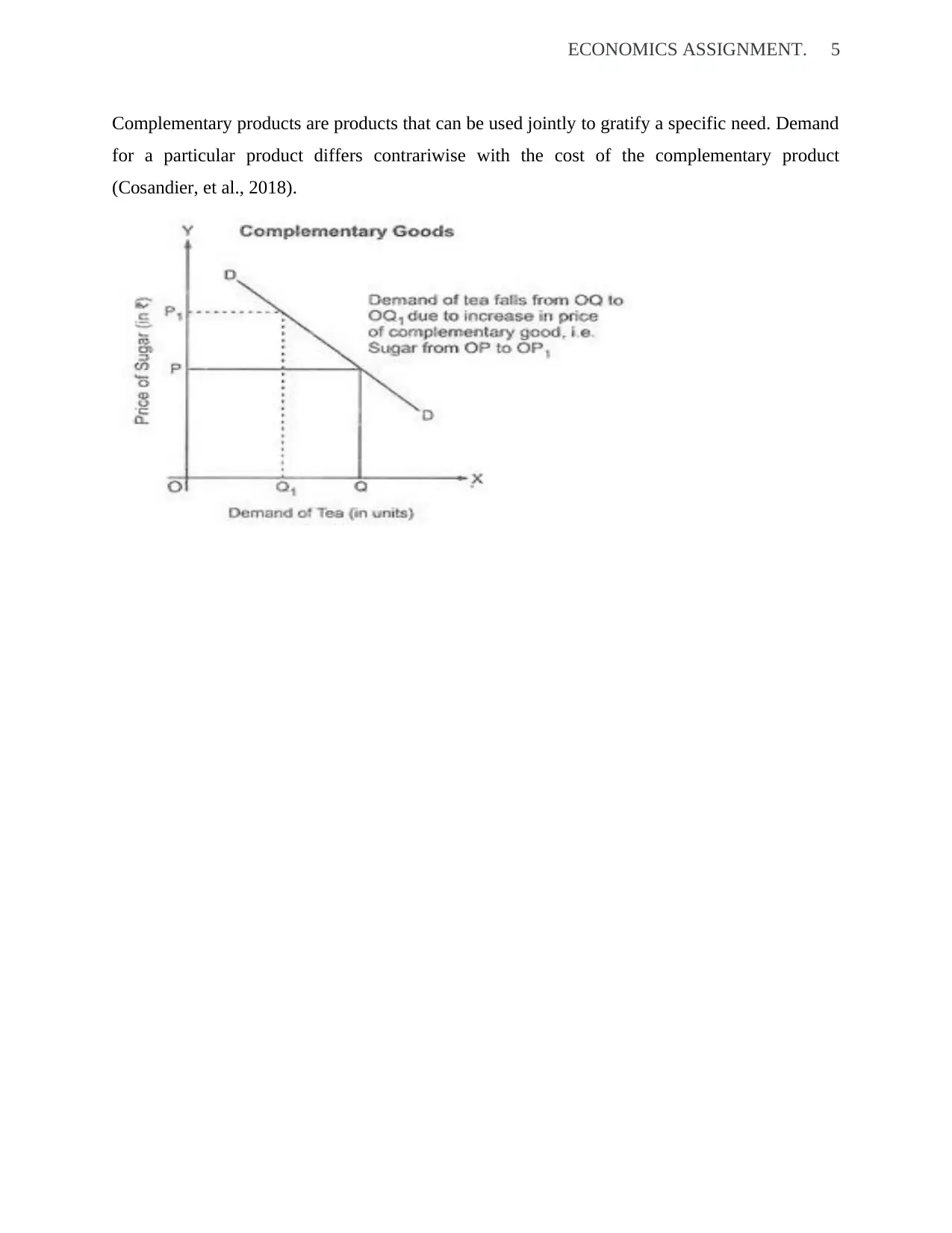
ECONOMICS ASSIGNMENT. 5
Complementary products are products that can be used jointly to gratify a specific need. Demand
for a particular product differs contrariwise with the cost of the complementary product
(Cosandier, et al., 2018).
Complementary products are products that can be used jointly to gratify a specific need. Demand
for a particular product differs contrariwise with the cost of the complementary product
(Cosandier, et al., 2018).
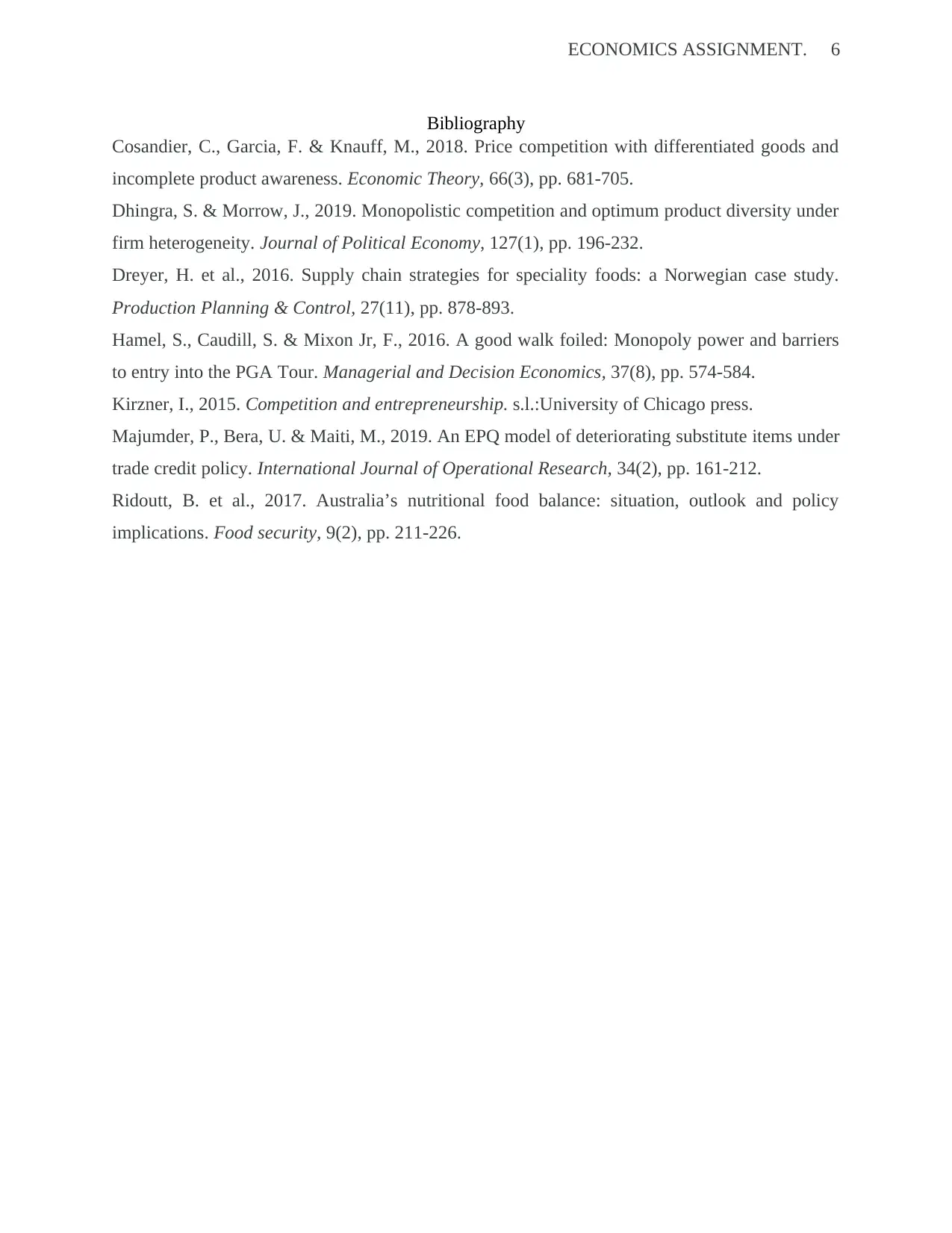
ECONOMICS ASSIGNMENT. 6
Bibliography
Cosandier, C., Garcia, F. & Knauff, M., 2018. Price competition with differentiated goods and
incomplete product awareness. Economic Theory, 66(3), pp. 681-705.
Dhingra, S. & Morrow, J., 2019. Monopolistic competition and optimum product diversity under
firm heterogeneity. Journal of Political Economy, 127(1), pp. 196-232.
Dreyer, H. et al., 2016. Supply chain strategies for speciality foods: a Norwegian case study.
Production Planning & Control, 27(11), pp. 878-893.
Hamel, S., Caudill, S. & Mixon Jr, F., 2016. A good walk foiled: Monopoly power and barriers
to entry into the PGA Tour. Managerial and Decision Economics, 37(8), pp. 574-584.
Kirzner, I., 2015. Competition and entrepreneurship. s.l.:University of Chicago press.
Majumder, P., Bera, U. & Maiti, M., 2019. An EPQ model of deteriorating substitute items under
trade credit policy. International Journal of Operational Research, 34(2), pp. 161-212.
Ridoutt, B. et al., 2017. Australia’s nutritional food balance: situation, outlook and policy
implications. Food security, 9(2), pp. 211-226.
Bibliography
Cosandier, C., Garcia, F. & Knauff, M., 2018. Price competition with differentiated goods and
incomplete product awareness. Economic Theory, 66(3), pp. 681-705.
Dhingra, S. & Morrow, J., 2019. Monopolistic competition and optimum product diversity under
firm heterogeneity. Journal of Political Economy, 127(1), pp. 196-232.
Dreyer, H. et al., 2016. Supply chain strategies for speciality foods: a Norwegian case study.
Production Planning & Control, 27(11), pp. 878-893.
Hamel, S., Caudill, S. & Mixon Jr, F., 2016. A good walk foiled: Monopoly power and barriers
to entry into the PGA Tour. Managerial and Decision Economics, 37(8), pp. 574-584.
Kirzner, I., 2015. Competition and entrepreneurship. s.l.:University of Chicago press.
Majumder, P., Bera, U. & Maiti, M., 2019. An EPQ model of deteriorating substitute items under
trade credit policy. International Journal of Operational Research, 34(2), pp. 161-212.
Ridoutt, B. et al., 2017. Australia’s nutritional food balance: situation, outlook and policy
implications. Food security, 9(2), pp. 211-226.
⊘ This is a preview!⊘
Do you want full access?
Subscribe today to unlock all pages.

Trusted by 1+ million students worldwide
1 out of 6
Related Documents
Your All-in-One AI-Powered Toolkit for Academic Success.
+13062052269
info@desklib.com
Available 24*7 on WhatsApp / Email
![[object Object]](/_next/static/media/star-bottom.7253800d.svg)
Unlock your academic potential
Copyright © 2020–2025 A2Z Services. All Rights Reserved. Developed and managed by ZUCOL.

![Strategic Analysis of Fonterra: MGT5STR Report - [University]](/_next/image/?url=https%3A%2F%2Fdesklib.com%2Fmedia%2Fimages%2Fpq%2Fa5f7f4e8c8a94866ac4a44a047727012.jpg&w=256&q=75)


